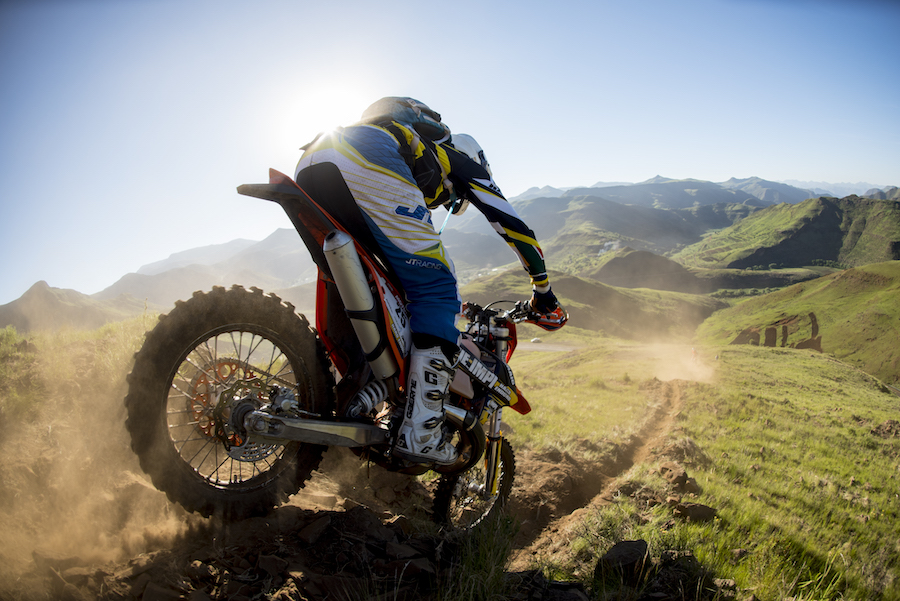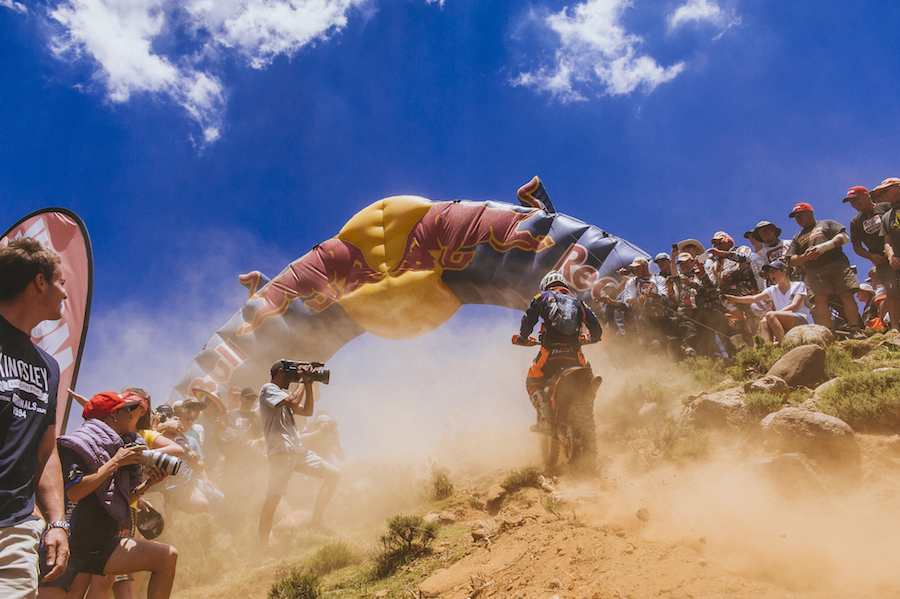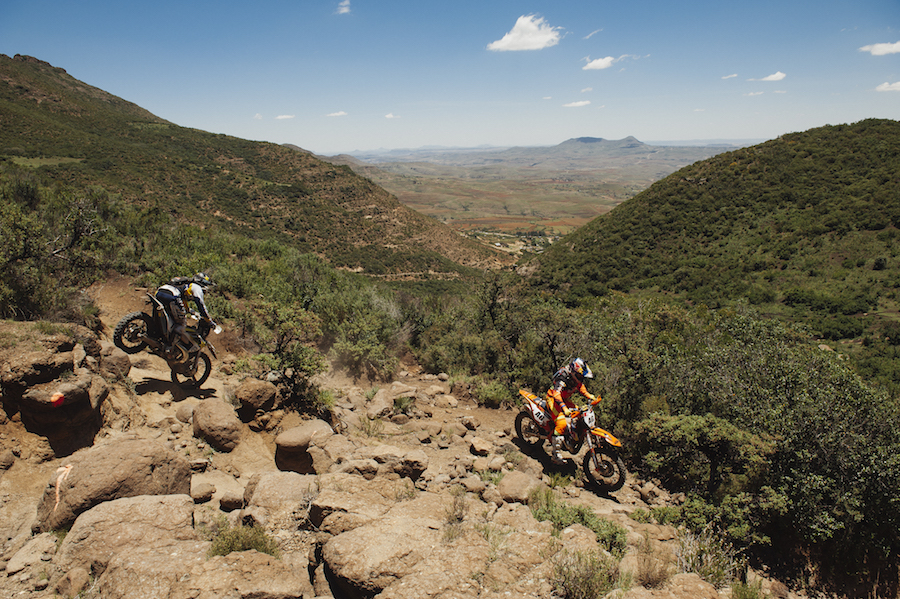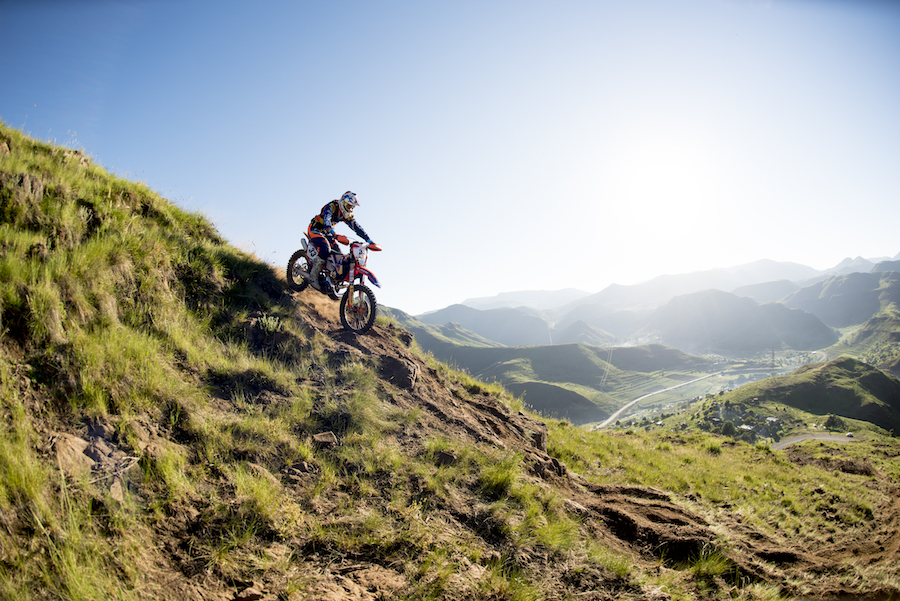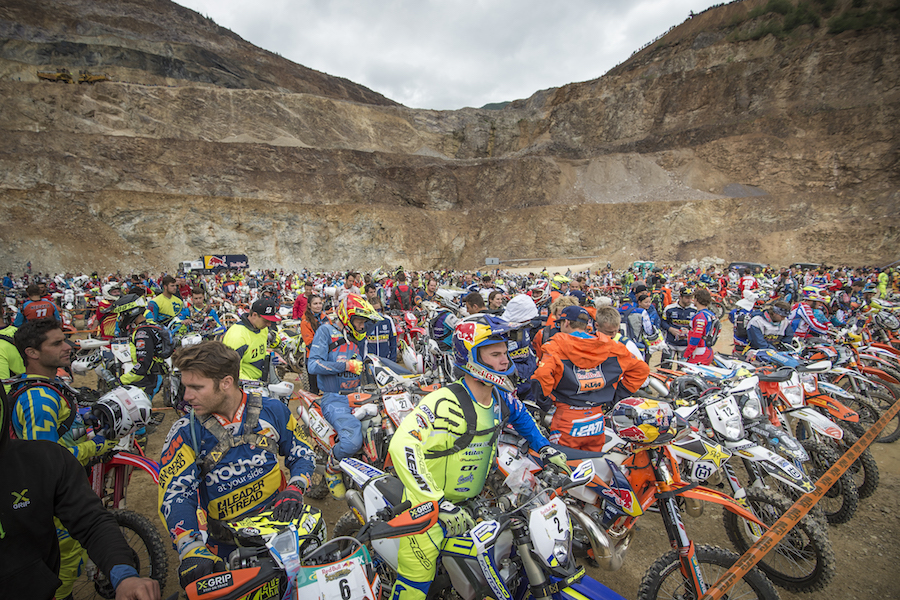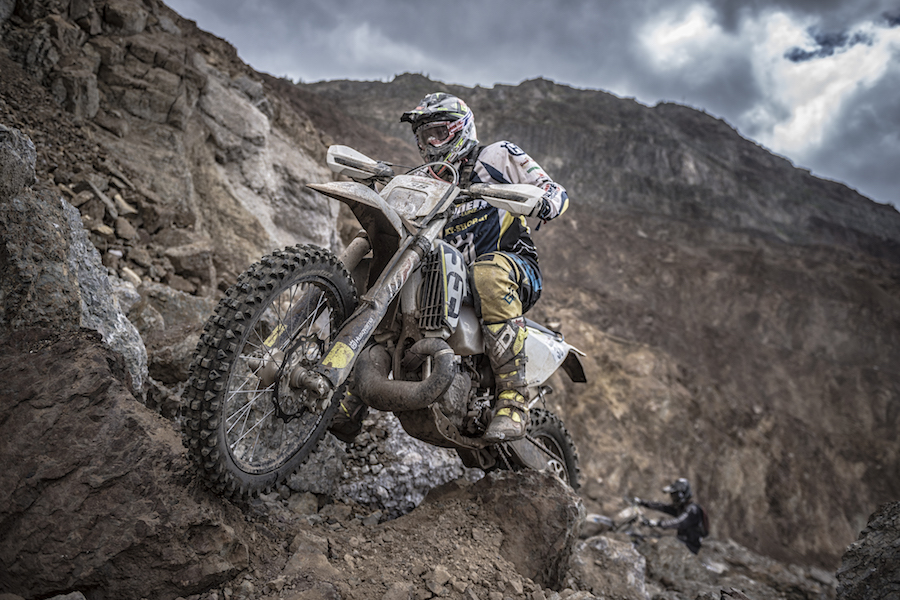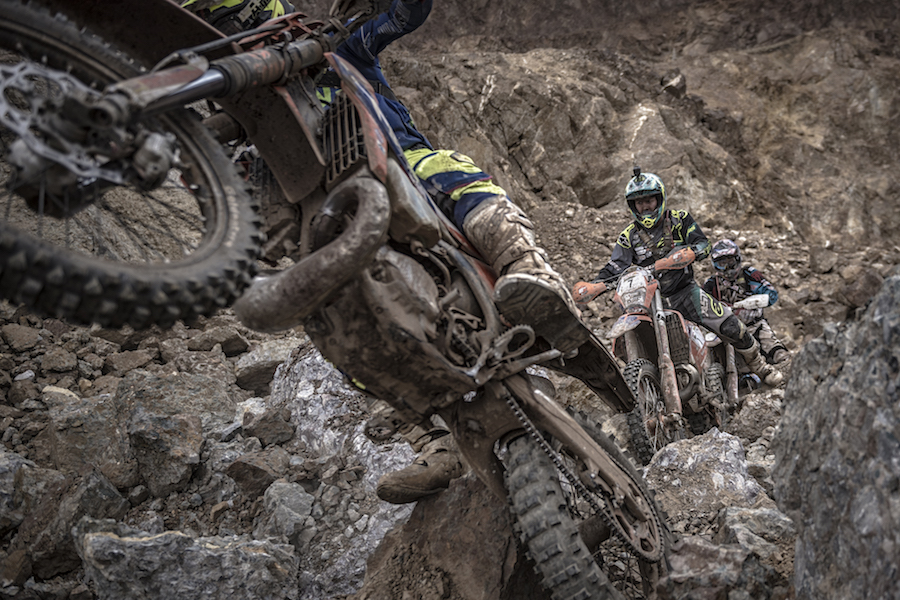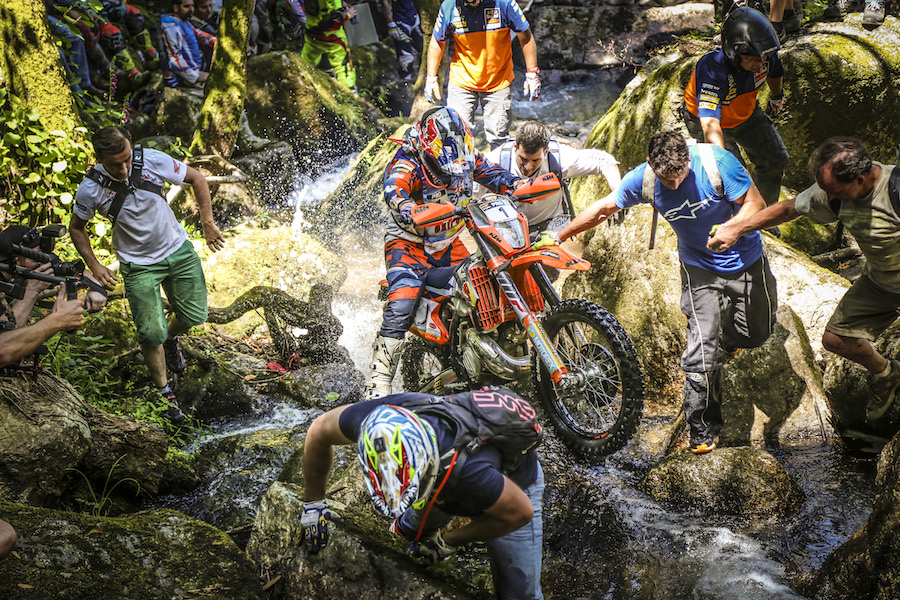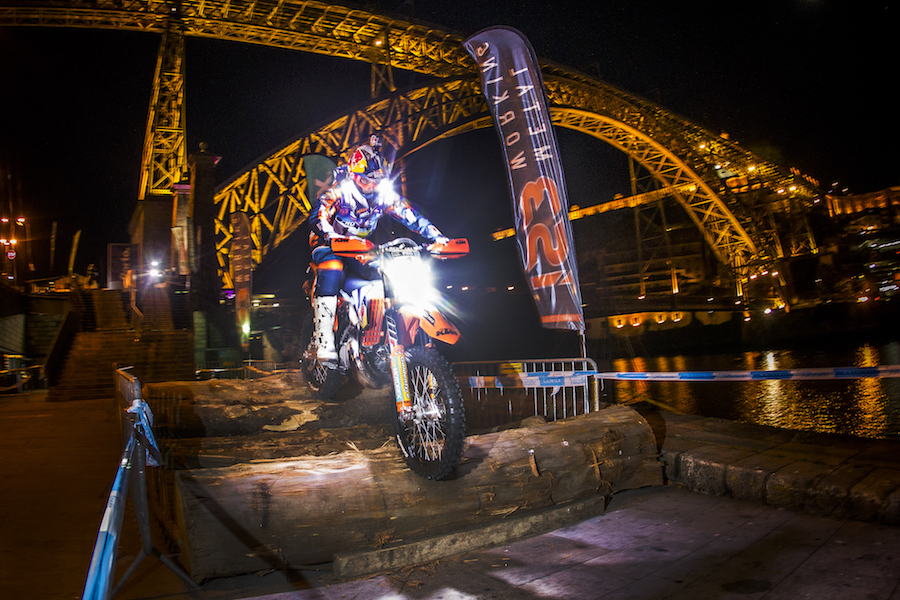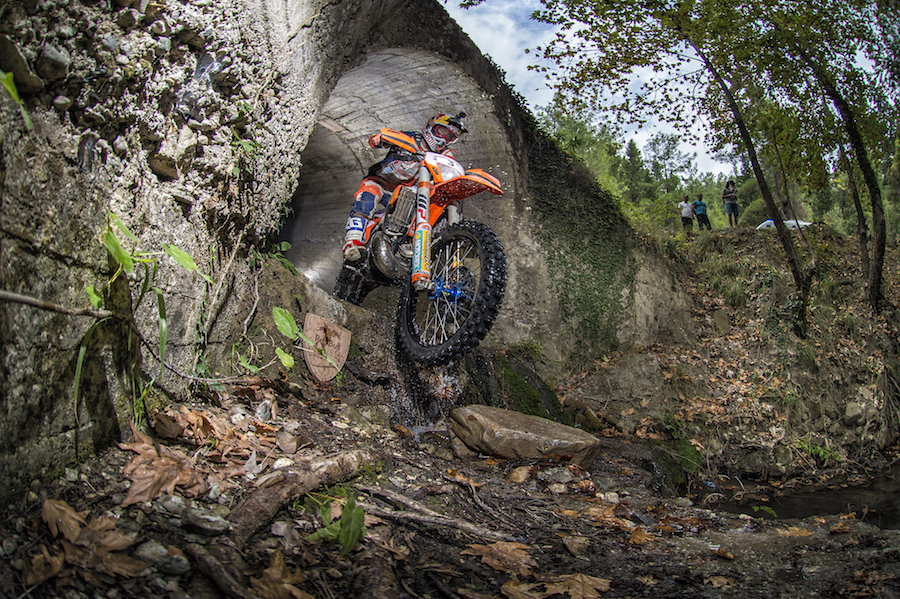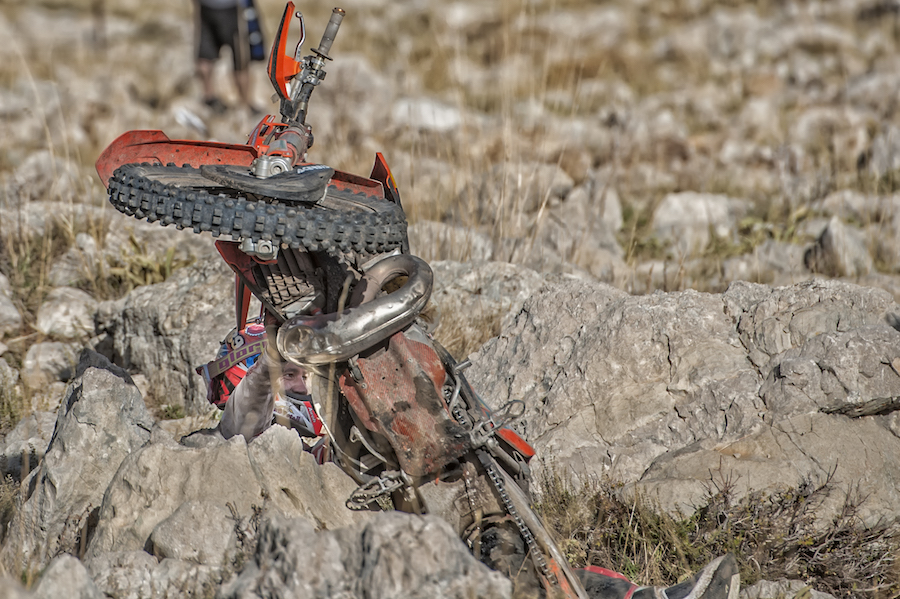Hard Enduro. Yep, it’s a thing. It’s a bruising, bloody and brutal series where only the toughest of racers dare to do battle
The truth is, somewhere along the line someone has described each and every one of the 17 rounds of the World Hard Enduro Series (WHES) as “the world’s toughest”, and frankly, none of them can be argued wrong. They’re mental, asking body, brain and bike to achieve what most dirtbike riders would deem impossible.
It’s a series where some huge names of off-road racing have congregated, people like Dakar legend Cyril Despres, five-time British trials champ Graham Jarvis, 12-time world trials champ Dougie Lampkin, British enduro ace Jonny Walker, and six-time SuperEnduro world champion Taddy Blazusiak.
It’s not FIM-sanctioned, though the commitment, talent and sacrifice of each and every rider makes it deserving of official world championship status. But the benefit is that amateurs and pros can line up in the same event, and it means the entry lists swell into the thousands and the spectacle is enormous. None more than the rounds (up to five each year) which are identified as particularly difficult, and are awarded double points.
These WHES rounds are dubbed as ‘Epic’ and can change each year. On the following pages are five deemed worthy…
The Mother
It might look spectacularly serene, but the Roof of Africa is known as the mother of Hard Enduro, the toughest and most gruelling of them all.
Now in its 52nd year, the notorious Roof of Africa began in 1965 and was so wildly difficult that the organisers of what was then a car race didn’t expect anyone to make it to the finish. Instead, they planned to drive back from the chequered flag to find the competitor who had made it the furthest before his mind, body or vehicle had cried no more and declare them the winner.
Motorcycles joined The Roof of Africa in 1969, and by 2000 the course had become so ridiculously extreme that it was impassable by anything other than a modern-day enduro bike.
- Participant performs during stage 2 at the Motul Roof of Africa in Maseru, Lesotho on December 3, 2016.
- Participant performs during Day 3 of the Motul Roof of Africa in Maseru, Lesotho on December 3, 2016
- Graham Jarvis and Alfredo Gomez perform during Day 2 of the Motul Roof of Africa in Maseru, Lesotho on December 2, 2016
Hosted by the land-locked nation of Lesotho and held on South Africa’s highest mountain range, the event sees competitors race for three days in extreme temperatures and at altitudes of up to 3000m.
Fighting altitude sickness and dehydration, riders need to overcome constant punishment just to make the finish line.
The event is broken up into three classes, Gold, Silver and Bronze, and it’s only the toughest and best-prepared riders who can attempt the Gold class, which is longer and harder than the others. Last year, 450 locals and 23 international racers entered and South African Kirsten Landman made history by becoming the first woman to enter (and finish!) the Roof’s gruelling Gold category.
The 2016 event claimed the life of another South African, Willie-John Le Hanie, who crashed and broke his neck. Remarkably, it was the event’s first fatality in more than half a century of extreme racing.
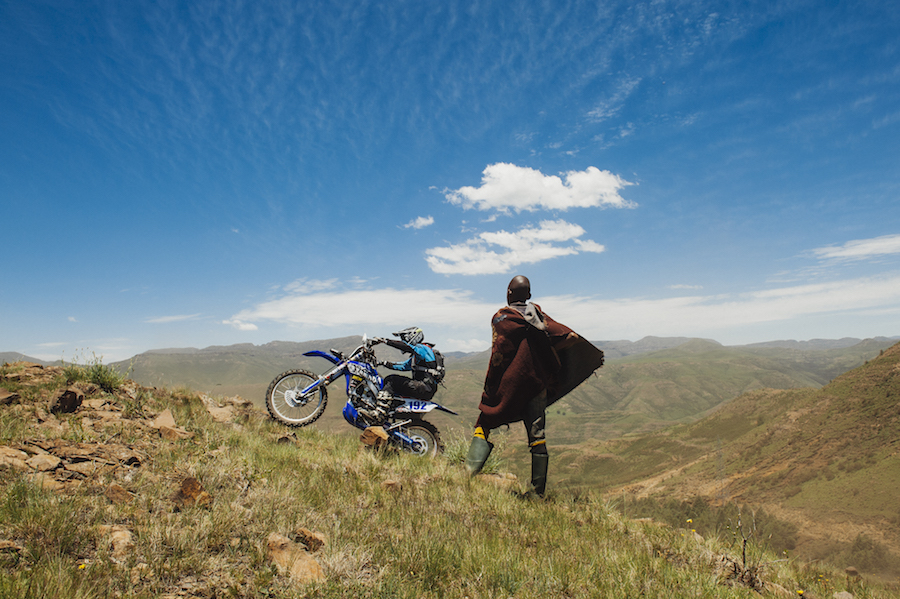
Janiel De Villiers performs during the time trial at the Roof of Africa in Maseru, Lesotho on December 1, 2016
Event : Roof of Africa
First held : 1965
Most successful : Alfie Cox, nine wins
Last winner: Graham Jarvis, 2016
What’s extreme : Heat, altitude
Next event : 16-18 November 2017
- Graham Jarvis and Alfredo Gomez perform during Day 2 of the Motul Roof of Africa in Maseru, Lesotho on December 2, 2016
- Participant suffers exhaustion during Day 2 of the Motul Roof of Africa in Maseru, Lesotho on December 2, 2016
- Scott Bouverie performs during stage 2 at the Motul Roof of Africa in Maseru, Lesotho on December 3, 2016.
Iron Giant
For the past 23 years, more than 1500 riders have gathered in the bottom of an iron ore mine in Austria to compete in a couple of brutal races in a bid to be one of just 500 qualifiers for the notorious Hare Scramble, the highlight of the annual event.
Hard Enduro events are generally take place in visually spectacular locations and the Erzbergrodeo is no exception. It’s held at the Erzberg mine in Austria’s Eisenerz, a functional open-pit mine that annually produces more than two million tonnes of iron ore.
The event is made up of the Iron Road Prologue, a high-speed blast up the mine’s 13.5km access road, and any machine, including roadbikes and quads, are allowed to take part. Pure bravery is just as important as honed riding skill in
the race from the base of the pit to the summit.
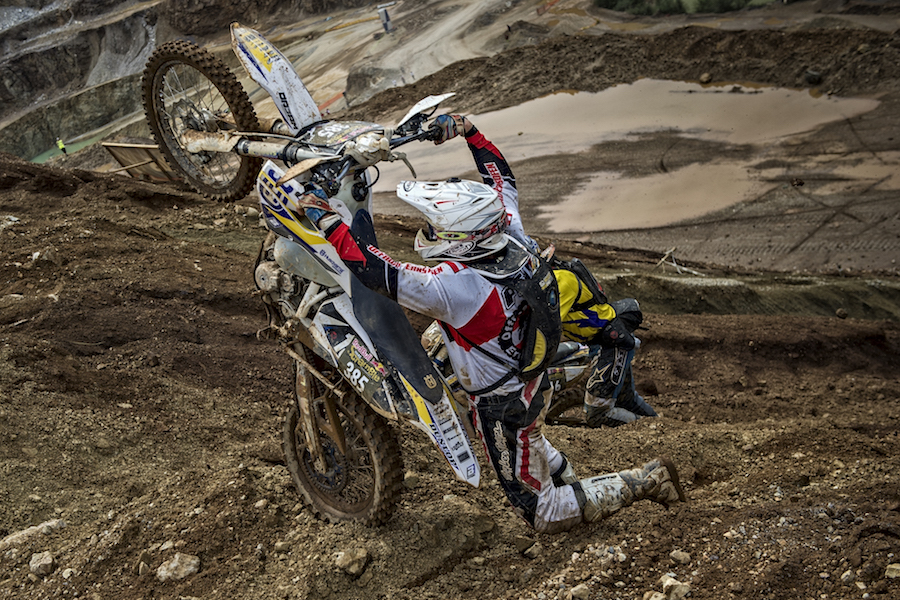
Athlete performs at the Red Bull Hare Scramble, Eisenerz, Austria on May 29, 2016
Then there’s the Rocket Ride, which, as the name suggests, is flying as fast as possible up an almost vertical climb. With packs of 300 riders at a time, the MX-style start gate drops and it’s on – straight up and wide open. The first three from each heat make up the 48 riders in the Superfinal.
The four-day event culminates in the Hare Scramble on a 35km trail that changes from year to year and it’s normal to take up to four hours to complete the course.
Refreshingly, the Erzbergrodeo is as silly as it is hard, evidenced by the scooters and roadbikes taking part in the prologue, but also highlighted in the event’s much-loved Storming of Eisenerz. The Storming of Eisenerz sees each and every competitor dress up in a silly costume – or often go completely naked – and ride into the local township for Eisenerz’s biggest and wildest party of the year.
- Competitors prepare to race during the Red Bull Hare Scramble 2017 in Eisenerz, Austria on June 18,2017
- Participant races during the Red Bull Hare Scramble at the Erzberg in Eisenerz, Austria on June 18, 2017. Photo by Sebastian Marko for Red Bull Contentpool
- Paul Bolton of Great Britain races during the Red Bull Hare Scramble at the Erzberg in Eisenerz, Austria on June 18, 2017. Photo by Sebastian Marko for Red Bull Contentpool
Event : Erzbergrodeo
First held : 1995
Most successful : Taddy Blażusiak, five wins
Last winner : Alfredo Gómez, 2017
What’s extreme : Scenery, terrain
Next event : 2018, date TBA

Wade Young struggles to get through Lazy Noon section during Red Bull Hare Scramble 2016 in Eisenerz, Austria on May 29, 2016, 2016
Concrete Jungle
This one’s an event that’s more like a high-speed inner-city police chase from a Hollywood movie than an international enduro race – well at least half of it is.
Held over two days in two separate areas of Portugal, about an hour away from each other, the Extreme Lagares XL is the brainchild of local enduro rider Paulo Moreira, who broke both arms in 2003 and spent recovery time walking his dog through Porto’s old city centre of Ribeira, including its many narrow and steep stairwells. It was on these walks where he dreamt up this crazy and extreme event.

Participant performs at Extreme XL Lagares in Porto, Portugal on June 17, 2016
The event kicks off with the prologue in Ribeira on Saturday morning before the urban setting plays hosts to the evening’s EnduroCross special held under the cover of darkness. Stairwells, retaining walls and footpaths adjacent to roads heaving with traffic form the trials-like urban trail tackled by the best enduro riders in the world. And while ambient light is provided for the spectators, the riders are forced to rely on headlights and helmet-mounted lighting to illuminate their course.
The feature race is held the following morning in the mountain ranges near the village of Lagares, and it more than lives up to its Hard Enduro moniker. The course is always wet and extremely slippery, and competitors must race deep in the forest through dense bush and rocky riverbeds. And, just like the prologue, the drama becomes even more extreme when darkness falls and the
race goes on…
- Alfredo Gomez performs during Extreme XL Lagares in Porto, Portugal on June 19, 2016.
- Alfredo Gomez performs during Extreme XL Lagares in Porto, Portugal on June 17, 2016.
- Alfredo Gomez performs at Extreme XL Lagares in Porto, Portugal on June 17, 2016
Event : Extreme XL Lagares
First held : 2011
Most successful rider : Alfredo Gómez, three wins
Last winner : Wade Young, 2017
What’s extreme : City setting, darkness
Next event : 2018, date TBA
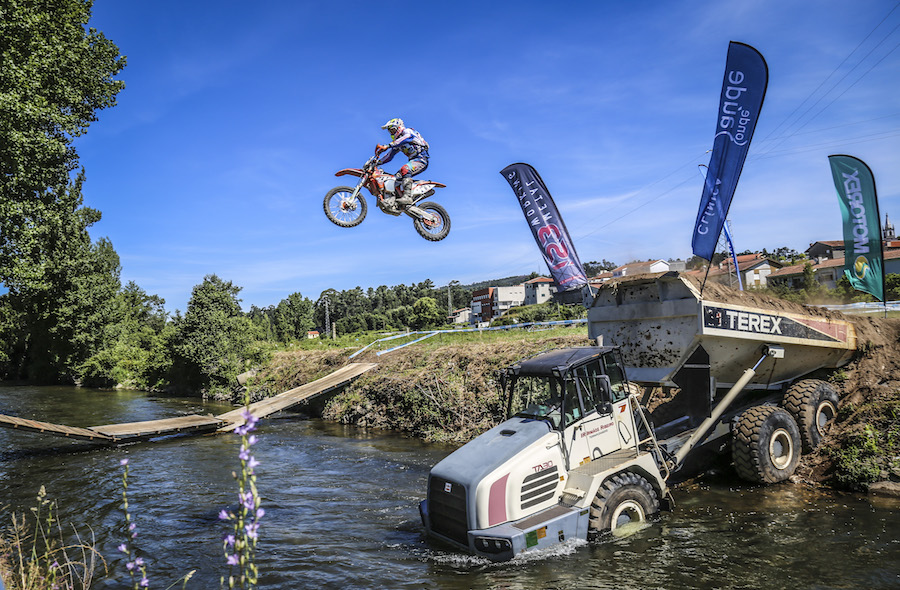
Wade Young performs during Extreme XL Lagares in Porto, Portugal on June 19, 2016.
Cruel Climb
It’s what Graham Jarvis has described as the most enjoyable Hard Enduro event due to its beachside setting and late-summer timing, but the annual Sea to Sky race is anything but.
Held in Kemer on the Turkish Riviera, Sea to Sky is a three-day event that asks more of the riders as the race progresses, culminating in a seven-hour sprint covering 65km, starting from sea level in the sun and finishing 2365m higher in the clouds. Literally.
Day one kicks off with a beach race, which more resembles a motocross event as the track makes use of sand dunes and inlets, but it’s important to do well because the finishing positions determine the next day’s starting positions.
That sees competitors tackle the forest leg of the event, a 50km loop usually reserved for walkers due to its remote and extreme nature, where again finishing positions dictate the starting order for the next day’s blue riband race up Turkey’s imposing Mount Olympos.
Impressively, the best riders can complete the forest leg within two hours, which means they’re traversing the rocky and challenging single trails at an average of 25km/h, and those top riders often even admit they take the Forest Race pretty easy in a
bid to conserve energy for the whopper finale. This final day sees hundreds of riders leave the start line on the beach, but rarely sees more than 30 make it to the finish high up above the tree line.
The climb from the beach to the top of Mt Olympos is where heat and fatigue weaken the riders’ bodies in the first half before cold temperatures and altitude batter them towards the finish line. In the end, it comes down to a race that’s won by the mentally fittest.
- Manuel Lettenbichler performs during Mountain Race at Red Bull Sea to Sky in Antalya, Kemer, Turkey on October 08th, 2016
- Competitor performs during Forest Race at Red Bull Sea to Sky in Antalya, Kemer, Turkey on October 07th, 2016
- Andreas Lettenbichler performs during Mountain Race at Red Bull Sea to Sky in Antalya, Kemer, Turkey on October 08th, 2016
Event : Sea to Sky
First held : 2010
Most successful : Graham Jarvis, four wins
Last winner : Lars Enöckl, 2016
What’s extreme : Variety, altitude
Next event : 28-30 September 2017
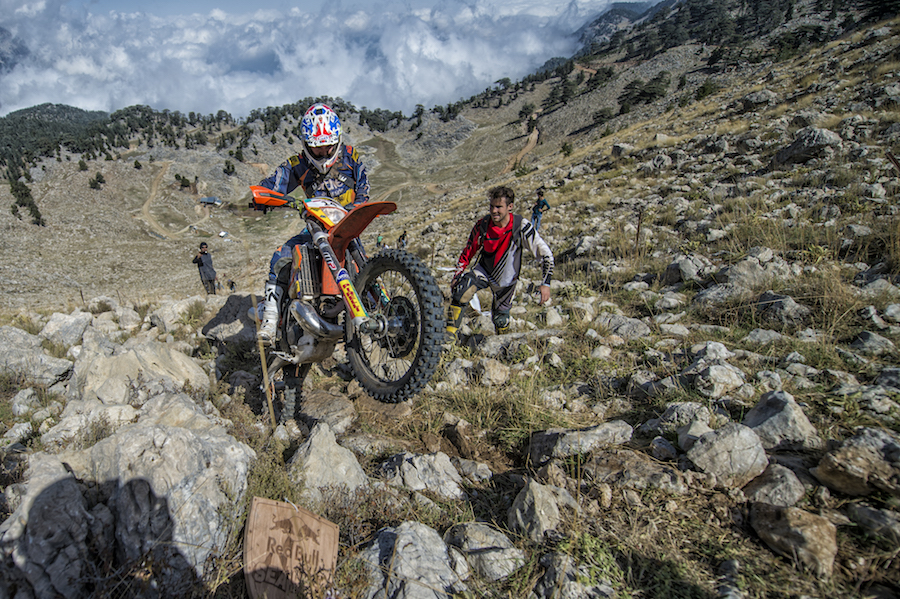
Scott Bouverie performs during Mountain Race at Red Bull Sea to Sky in Antalya, Kemer, Turkey on October 08th, 2016
EXTREME ENDURANCE
The Red Bull Romaniacs is perhaps the best-known Hard Enduro event due to its wildly spectacular prologue event, which is hosted in the Romanian city of Sibiu, and televised in more than 215 countries.
Now in its 14th year, the Romaniacs has attracted some big names over its time, with high-profile riders such as Cyril Despres, Chris Birch and Jonny Walker all adding their names to the coveted winner’s trophy at least once.
It’s a five-day event that challenges even the best riders in the world, beginning with the prologue to determine the starting order, before the serious four-day off-road race gets underway.
The race is the work of former snowboarding world champ Martin Freinademetz and borrows various elements from international rally events, asking riders to complete timed special sections, independent GPS navigational sections and unassisted fuel stops as well as the super-challenging rocky, single-trail and steep mountain climbs we’ve come to expect from the series.
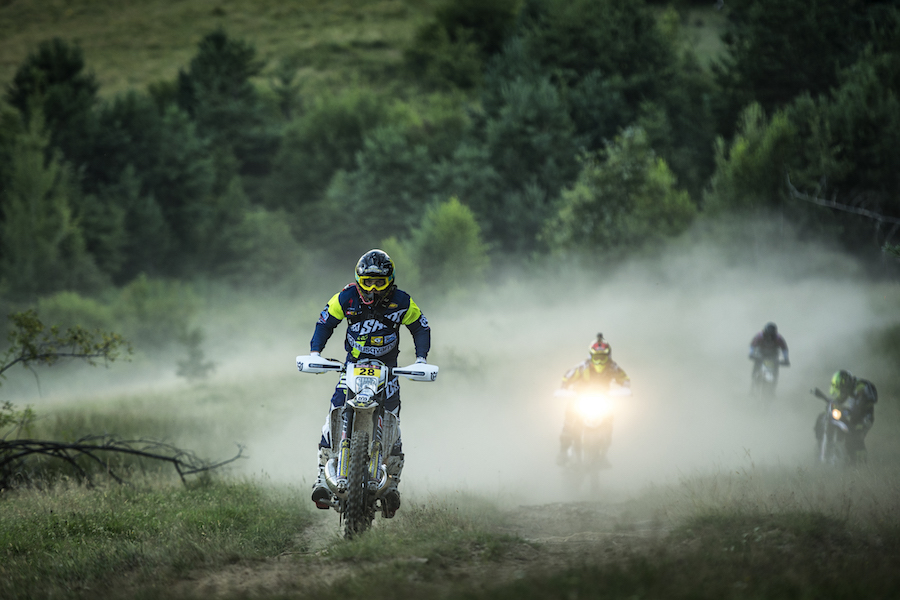
Mario Roman of Spain performs during the second race day at the Red Bull Romaniacs in Sibiu, Romania on July 14th, 2016
The event consists of days up to 180km long covering some of Romania’s gnarliest terrain. Heavily wooded forests, sloshy mud, rocky outcrops, river crossings and every other extreme environment you could imagine, all while riders plot their own race using GPS co-ordinates.
To illustrate just how intense the Romaniacs event is, the race regulations stipulate that each competitor carry the following items on their person: a lighter, a GSM mobile phone, a torch, six rocket flares or two red hand-held smoke flares, a compass, a distress mirror, a survival blanket and a pencil. And, further down the list, a toolkit, a spare tube, an extra sparkplug and, last of all, a helmet.
- James Nicholls performs during the third race day at the Red Bull Romaniacs in Sibiu, Romania on July 15, 2016.
- Participants performs during the prologue race at the Red Bull Romaniacs in Sibiu, Romania on July 12th, 2016.
- Paul Bolton of Great Britain and Wade Young of South Africa perform during the first race day at the Red Bull Romaniacs in Sibiu, Romania on July 13th, 2016
Event : Romaniacs
First held : 2004
Most successful : Graham Jarvis, five wins
Last winner: Graham Jarvis, 2016
What’s extreme : Endurance
Next event : 25-29 July, 2017
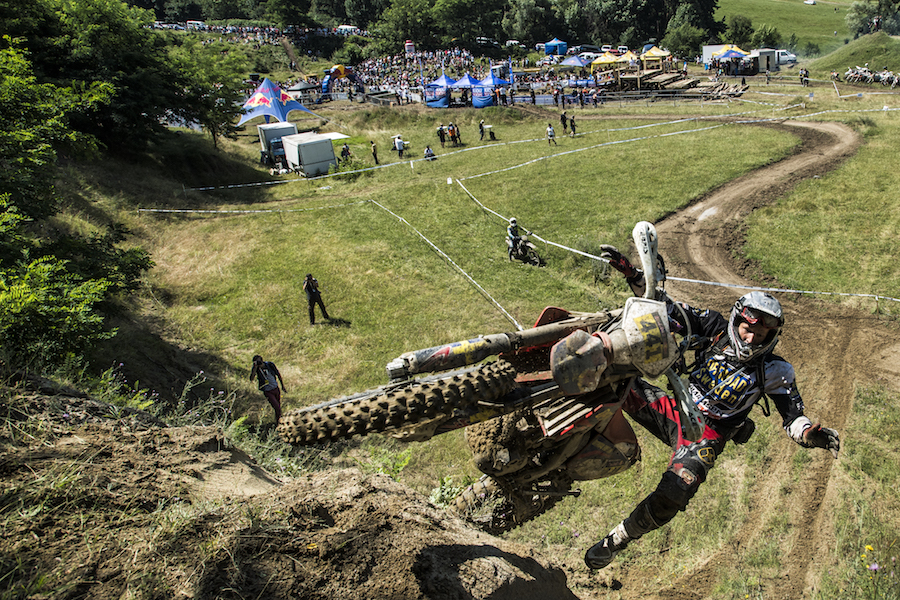
Wilco de Lange performs during the fourth race day at the Red Bull Romaniacs in Sibiu, Romania on July 16th, 2016
WORDS Kel Buckley
PHOTOGRAPHY Red Bull
